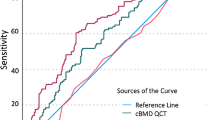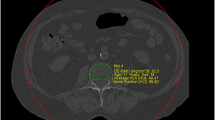Abstract
Objectives
To evaluate the utility of femoral bone mineral density (BMD) measurements in routine contrast-enhanced multi-detector computed tomography (ceMDCT) using dual-energy X-ray absorptiometry (DXA) as the reference standard.
Methods
Forty-one patients (33 women, 8 men) underwent DXA measurement of the proximal femur. Subsequently, transverse sections of routine ceMDCT of these patients were used to measure BMD of the femoral head and femoral neck. The MDCT-to-DXA conversion equations for BMD and T-score were calculated using linear regression analysis. The conversion equations were applied to the MDCT data sets of 382 patients (120 women, 262 men) of whom 74 had osteoporotic fractures.
Results
A correlation coefficient of r = 0.84 (P < 0.05) was calculated for BMDMDCT values of the femoral head and DXA T-scores of the total proximal femur using the conversion equation T-score = 0.021 × BMDMDCT − 5.90. The correlation coefficient for the femoral neck was r = 0.79 (P < 0.05) with the conversion equation T-score = 0.016 × BMDMDCT − 4.28. Accordingly, converted T-scores for the femoral neck in patients with versus those without osteoporotic fractures were significantly different (female, −1.83 versus −1.47; male, −1.86 versus −1.47; P < 0.05).
Conclusion
BMD measurements of the proximal femur were computed in routine contrast-enhanced MDCT and converted to DXA T-scores, which adequately differentiated patients with and without osteoporotic fractures.
Key Points
• BMD measurements of the femur could be derived from routine abdominal ceMDCT.
• Derived T-scores could differentiate patients with and without osteoporotic fractures.
• Attenuation measurements in the femur in ceMDCT may predict fracture risk.



Similar content being viewed by others
References
Consensus Development Panel on Osteoporosis Prevention, Diagnosis and Therapy (2001) Osteoporosis prevention, diagnosis, and therapy. JAMA 285:785–795
Sanchez-Riera L, Wilson N, Kamalaraj N et al (2010) Osteoporosis and fragility fractures. Best practice & research. Clin Rheumatol 24:793–810
Ioannidis G, Papaioannou A, Hopman WM et al (2009) Relation between fractures and mortality: results from the Canadian Multicentre Osteoporosis Study. CMAJ 181:265–271
Boonen S, Autier P, Barette M, Vanderschueren D, Lips P, Haentjens P (2004) Functional outcome and quality of life following hip fracture in elderly women: a prospective controlled study. Osteoporos Int 15:87–94
Jiang HX, Majumdar SR, Dick DA et al (2005) Development and initial validation of a risk score for predicting in-hospital and 1-year mortality in patients with hip fractures. J Bone Miner Res 20:494–500
Cauley JA, Thompson DE, Ensrud KC, Scott JC, Black D (2000) Risk of mortality following clinical fractures. Osteoporos Int 11:556–561
Bliuc D, Nguyen ND, Milch VE, Nguyen TV, Eisman JA, Center JR (2009) Mortality risk associated with low-trauma osteoporotic fracture and subsequent fracture in men and women. JAMA 301:513–521
Cole ZA, Dennison EM, Cooper C (2008) Osteoporosis epidemiology update. Curr Rheumatol Rep 10:92–96
Blake GM, Fogelman I (2010) An update on dual-energy x-ray absorptiometry. Semin Nucl Med 40:62–73. doi:10.1053/j.semnuclmed.2009.08.001
Adams JE (2009) Quantitative computed tomography. Eur J Radiol 71:415–424
Guglielmi G, de Terlizzi F (2009) Quantitative ultrasond in the assessment of osteoporosis. Eur J Radiol 71:425–431
Lewiecki EM, Gordon CM, Baim S et al (2008) International society for clinical densitometry 2007 adult and pediatric official positions. Bone 43:1115–1121
Blake GM, Fogelman I (2009) The clinical role of dual energy X-ray absorptiometry. Eur J Radiol 71:406–414
Gralow JR, Biermann JS, Farooki A et al (2009) NCCN task force report: bone health in cancer care. J Natl Compr Cancer Netw7:S1–32, quiz S33–35
Guise TA (2006) Bone loss and fracture risk associated with cancer therapy. Oncologist 11:1121–1131
Yamamoto DS, Viale PH (2009) Update on identifying and managing osteoporosis in women with breast cancer. Clin J Oncol Nurs 13:E18–29
Smith MR (2006) Treatment-related osteoporosis in men with prostate cancer. Clin Cancer Res 12:6315s–6319s
WHO (1994) Assessment of fracture risk and its application to screening for postmenopausal osteoporosis. Report of a WHO Study Group (ed) World Health Organization technical report series, 1994/01/01, pp 1–129
Bauer JS, Henning TD, Mueller D, Lu Y, Majumdar S, Link TM (2007) Volumetric quantitative CT of the spine and hip derived from contrast-enhanced MDCT: conversion factors. AJR Am J Roentgenol 188:1294–1301
Link TM, Koppers BB, Licht T, Bauer J, Lu Y, Rummeny EJ (2004) In vitro and in vivo spiral CT to determine bone mineral density: initial experience in patients at risk for osteoporosis. Radiology 231:805–811
Baum T, Muller D, Dobritz M, Rummeny EJ, Link TM, Bauer JS (2011) BMD measurements of the spine derived from sagittal reformations of contrast-enhanced MDCT without dedicated software. Eur J Radiol 80:e140–145
Baum T, Muller D, Dobritz M, et al (2012) Converted lumbar BMD values derived from sagittal reformations of contrast-enhanced MDCT predict incidental osteoporotic vertebral fractures. Calcif Tissue Int 90:481–487
Pickhardt PJ, Lee LJ, del Rio AM et al (2011) Simultaneous screening for osteoporosis at CT colonography: bone mineral density assessment using MDCT attenuation techniques compared with the DXA reference standard. J Bone Miner Res 26:2194–2203
Papadakis AE, Karantanas AH, Papadokostakis G, Petinellis E, Damilakis J (2009) Can abdominal multi-detector CT diagnose spinal osteoporosis? Eur Radiol 19:172–176
Genant HK, Wu CY, van Kuijk C, Nevitt MC (1993) Vertebral fracture assessment using a semiquantitative technique. J Bone Miner Res 8:1137–1148
World Medical Association I (1964) Declaration of Helsinki – ethical principles for medical research involving human subjects
Hans D, Downs RW Jr, Duboeuf F et al (2006) Skeletal sites for osteoporosis diagnosis: the 2005 ISCD official positions. J Clin Densitom 9:15–21
Gluer CC, Blake G, Lu Y, Blunt BA, Jergas M, Genant HK (1995) Accurate assessment of precision errors: how to measure the reproducibility of bone densitometry techniques. Osteoporos Int 5:262–270
Griffith JF, Yeung DK, Tsang PH et al (2008) Compromised bone marrow perfusion in osteoporosis. J Bone Miner Res 23:1068–1075
Acknowledgments
This work was supported by grants from the Deutsche Forschungsgemeinschaft (DFG BA 4085/1-2).
Author information
Authors and Affiliations
Corresponding author
Rights and permissions
About this article
Cite this article
Gruber, M., Bauer, J.S., Dobritz, M. et al. Bone mineral density measurements of the proximal femur from routine contrast-enhanced MDCT data sets correlate with dual-energy X-ray absorptiometry. Eur Radiol 23, 505–512 (2013). https://doi.org/10.1007/s00330-012-2629-5
Received:
Revised:
Accepted:
Published:
Issue Date:
DOI: https://doi.org/10.1007/s00330-012-2629-5




